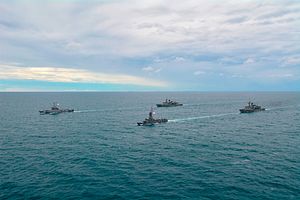Last week, Singapore and Thailand held another iteration of a biennial naval drill. The exercise once again put the spotlight on the defense side of the relationship between the two Southeast Asian states amid a wider domestic and regional developments.
As I have noted before, Singapore and Thailand have a defense relationship that not only includes traditional aspects like exchanges, visits and exercises, but also the fact that Singapore Armed Forces (SAF) has also had an overseas training area in Thailand, one of several arrangements it has with countries including Australia and the United States (See: “Strengthening US-Singapore Strategic Partnership: Opportunities and Challenges”).
The two Southeast Asian states also participate in several multilateral and minilateral interactions as well with fellow regional states and external powers as well. Both are playing particularly active roles in that respect during this period with Singapore holding the annually rotating chairmanship of the Association of Southeast Asian Nations (ASEAN) and Thailand set to take over in 2019 as the junta government looks to hold elusive elections (See: “Where are ASEAN’s Defense Initiatives Under Singapore’s Chairmanship?”).
On the naval side, a key bilateral interaction has been Exercise Singsiam. Held since 1981, the biennial exercise between the Republic of Singapore Navy (RSN) and the Royal Thai Navy (RTN) is hosted alternately by the two Southeast Asian states. Recent exercises have followed the general pattern of a mix of continuity amidst certain changes and growing complexity, with the 2015 iteration hosted by Singapore seeing some firsts such as Singapore’s deployment of a submarine to the exercise and both navies deploying naval helicopters jointly. From June 4 to June 9, the RSN and RTN carried out the 19th iteration of Exercise Singsiam in the Gulf of Thailand which was hosted by Thailand.
According to Singapore’s defense ministry (MINDEF), the exercise saw both sides conduct conventional warfare training in anti-surface and anti-air domains as well as maritime security training to enhance interoperability between the two navies. The exercise included gunnery live-firings, air defense and warfare training, as well as a combined boarding operation involving boarding teams from RSS Sovereignty and HTMS Taksin to conduct security checks on a simulated suspicious vessel.
On the Singapore side, assets that participated included the RSN’s Victory-class Missile Corvette RSS Vigour and Independence-class Littoral Mission Vessel RSS Sovereignty, which was on her inaugural overseas exercise since operationalization just last year, while on the Thai side, assets included the Naresuan-class Frigates HTMS Naresuan and HTMS Taksin, and a Dornier 228 and Fokker 27 Maritime Patrol Aircraft.

































